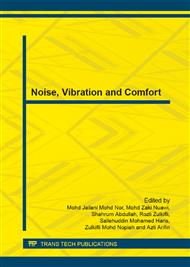p.20
p.25
p.30
p.35
p.40
p.45
p.52
p.59
p.64
Application of Feed-Forward Neural Networks for Classifying Acoustics Levels in Vehicle Cabin
Abstract:
Vehicle acoustical comfort and vibration in a passenger car cabin are the main factors that attract a buyer in car purchase. Numerous studies have been carried out by automotive researchers to identify and classify the acoustics level in the vehicle cabin. The objective is to form a special benchmark for acoustics level that may be referred for any acoustics improvement purpose. This study is focused on the sound quality change over the engine speed [rp to recognize the noise pattern experienced in the vehicle cabin. Since it is difficult for a passenger to express, and to evaluate the noise experienced or heard in a numerical scale, a neural network optimization approach is used to classify the acoustics levels into groups of noise annoyance levels. A feed forward neural network technique is applied for classification algorithm, where it can be divided into two phases: Learning Phase and Classification Phase. The developed model is able to classify the acoustics level into numerical scales which are meaningful for evaluation purposes.
Info:
Periodical:
Pages:
40-44
Citation:
Online since:
December 2013
Keywords:
Price:
Сopyright:
© 2014 Trans Tech Publications Ltd. All Rights Reserved
Share:
Citation:


